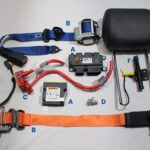Understanding and addressing Diagnostic Trouble Codes (DTCs) is a crucial part of modern vehicle maintenance. When your check engine light illuminates, an OBD2 scanner, like those from Innova, becomes an invaluable tool for deciphering the problem. A common question among car owners is: “How do I erase a code on my Innova OBD2 scanner?” While these scanners are powerful, the answer isn’t always straightforward, especially when dealing with different types of DTCs. This guide will break down the nuances of DTCs and explain how your Innova scanner interacts with them.
Understanding Diagnostic Trouble Codes (DTCs)
Before diving into code erasure, it’s essential to understand the different categories of DTCs your vehicle’s onboard computer system can generate. These codes are essentially alerts, signaling that something is not functioning as expected within your car’s complex network of systems. DTCs can be broadly categorized into Permanent DTCs (PDTCs), Pending DTCs, and History DTCs, each with its own characteristics and implications for clearing.
Permanent DTCs (PDTCs): The Un-erasable Codes
Permanent Diagnostic Trouble Codes, or PDTCs, are a specific type of code designed to ensure proper vehicle repairs are performed. According to the Bureau of Automotive Repair (BAR), PDTCs cannot be simply erased using an OBD2 scanner, including Innova scanners, or by disconnecting your car battery.
Alt text: Innova OBD2 scanner screen displaying diagnostic trouble codes, highlighting the complexity of automotive error messages.
The reason PDTCs are “permanent” in this context is rooted in their purpose. They are set when a monitor, which is a self-diagnostic routine within your vehicle’s computer, detects a problem. To clear a PDTC, you must address the underlying issue that triggered the code in the first place. Once the repair is completed, the vehicle needs to undergo sufficient drive cycles to re-run the monitor and confirm the fault is no longer present. Only when the monitor runs successfully without detecting the problem will the PDTC automatically clear itself. Therefore, if you’re facing a PDTC, your Innova OBD2 scanner can help you identify the problem, but it cannot directly erase the code until the root cause is fixed and verified by the vehicle’s system.
Pending DTCs: Temporary Warnings
Pending codes, sometimes referred to as intermittent codes, represent potential issues that the vehicle’s computer has detected but hasn’t yet confirmed as a hard fault. These codes arise from faults that occur sporadically or require confirmation over two consecutive warm-up cycles. A warm-up cycle generally refers to the process of the engine reaching its normal operating temperature and then cooling down.
Alt text: Illuminated check engine light on a car dashboard, signaling potential issues that may trigger pending DTCs.
If the intermittent fault does not reappear within approximately 40 warm-up cycles, the pending code will automatically disappear from the system’s memory. However, if the fault does recur within the specified number of warm-up cycles, the pending code will mature into a full Diagnostic Trouble Code (DTC). This progression will then typically activate the check engine light, alerting the driver to a persistent problem. Innova OBD2 scanners are capable of reading pending codes, allowing you to identify potential issues early, even before they trigger a permanent DTC and the check engine light. While you might be able to clear pending codes with an Innova scanner, it’s important to understand that if the underlying issue persists, the code, or potentially a more serious DTC, will likely return.
History DTCs: Records of Past Issues
History codes are essentially records of past DTCs that were once active and triggered the check engine light, but have since been resolved, either through repair or because the fault was temporary and self-corrected. Think of them as a vehicle’s memory of past glitches.
Clearing history codes is more variable than dealing with PDTCs. Many history codes can be erased using a scan tool like an Innova OBD2 scanner. In many cases, a simple code clearing function within the scanner’s menu will remove these codes from the vehicle’s memory. However, some history codes may require a “double code clearing” procedure, which involves clearing the codes twice in succession. Furthermore, certain history codes are designed to clear only after a specific number of ignition cycles or drive cycles have been completed, and often under very specific operating conditions.
Alt text: Automotive technician using an Innova OBD2 scanner to diagnose engine problems, highlighting the tool’s role in reading and potentially clearing history DTCs.
These history codes are archived to aid in diagnosing intermittent problems that might be difficult to track down. The presence of a history code can give a technician valuable clues about past issues, even if they are not currently active. Some history codes are intentionally designed to resist immediate erasure because the diagnostic tests required to properly evaluate the related system or component demand very specific operational conditions to run and verify proper repair.
To effectively clear a history code, it’s often advisable to consult the vehicle’s service manual specific to the code in question. The service manual will outline any specific conditions or procedures required for clearing that particular code. Following these conditions while driving the vehicle, and then using your Innova scanner to attempt a code clear, will provide the best chance of successfully erasing the history code.
In Conclusion
While Innova OBD2 scanners are powerful tools capable of reading and clearing many types of Diagnostic Trouble Codes, understanding the different categories of DTCs is crucial. When it comes to “erasing a code,” remember that Permanent DTCs are designed to remain until the underlying issue is properly repaired and verified by the vehicle’s self-diagnostic system. Pending and History DTCs offer more flexibility in clearing, often achievable with your Innova scanner, but always consider the root cause of any code. Using your Innova OBD2 scanner effectively involves not just erasing codes, but also understanding what those codes mean and taking appropriate action to ensure your vehicle is running reliably and efficiently.
